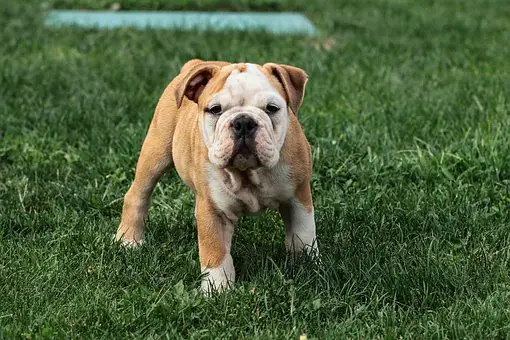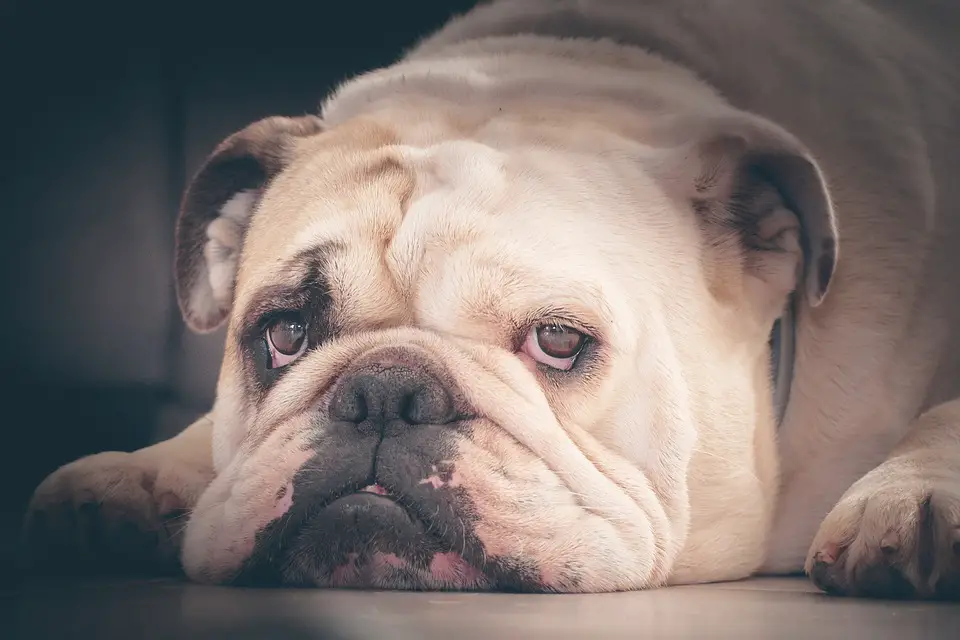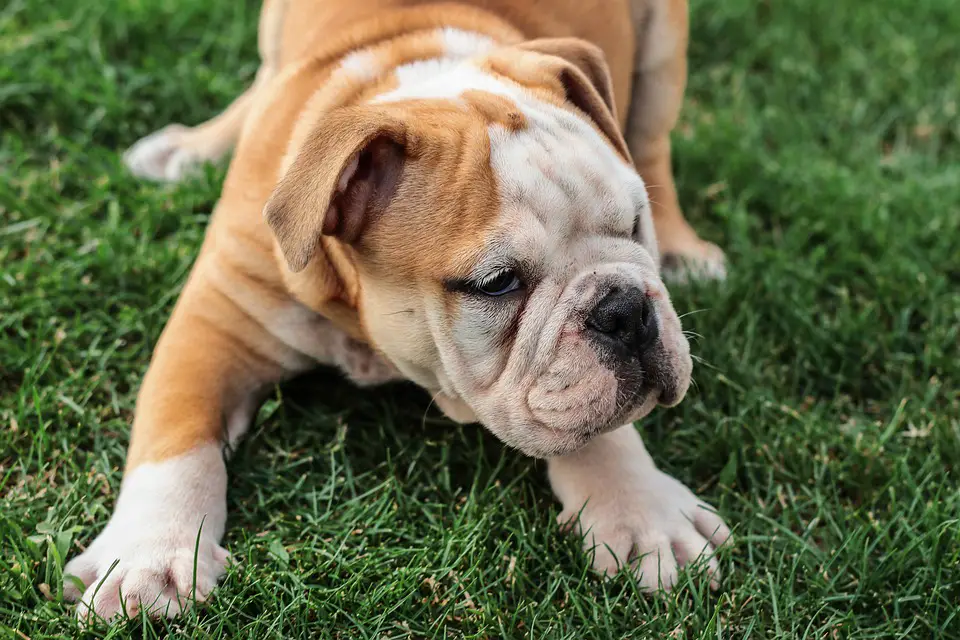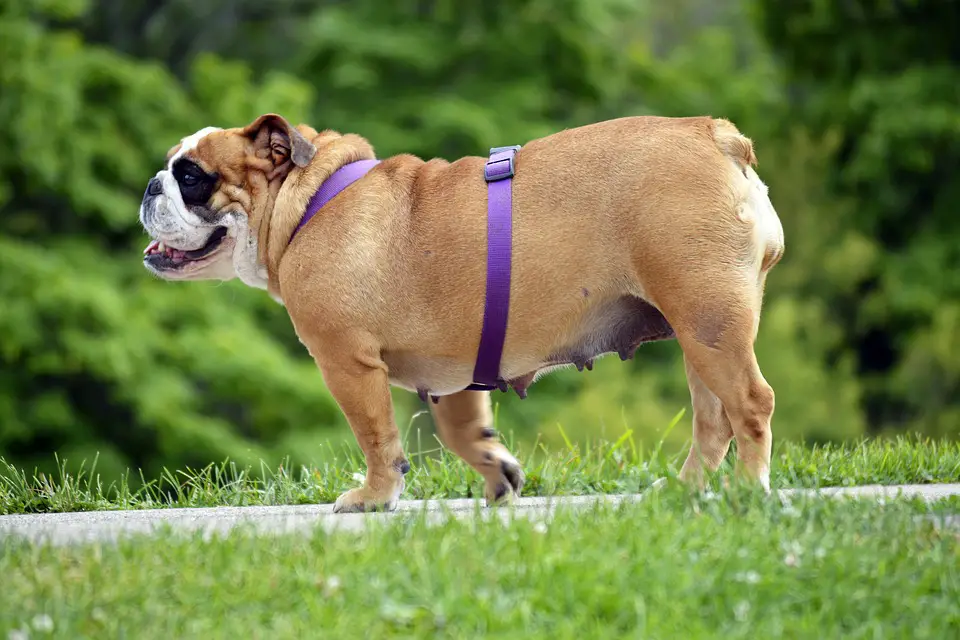Hip dysplasia in English bulldogs is a painful disorder that most common in English bulldogs. During growth, the hip joint and socket joint are starting to deform. Hip dysplasia is defined when the thigh ball or femoral head doesn’t match the socket joint or acetabulum correctly. The disorder usually exhibits in young dogs between 3 to 12 months of age.

Cases of hip dysplasia differ in the severity of deformation. It could be mild, moderate, or acute. Mild cases could cause mild arthritis, and the good news is, it is manageable and curable. But in acute cases where crippling pain arises, proper medication is needed for dogs.
What causes hip dysplasia in English Bulldogs?
Always remember that hip dysplasia is an inborn disease and the most significant factor to consider. A large breed of dogs mostly suffers from this disorder; however, smaller dogs like bulldogs could also develop hip dysplasia.
Here is the common factor that leads your dogs to hip dysplasia.
- Environment factors such as rapid gain weight and excessive exercise.
- Nutrition and lifestyle are also factors to consider because they play a significant role in developing muscle mass in bulldogs. Overdevelopment could lead to joint laxity.
- The injury also could develop hip dysplasia.
- Neutering a dog at a young age also has a double chance of developing this disorder.
- Growth
- Hormones
Can English Bulldogs live with hip dysplasia?
Hearing your pet that is suffering from hip dysplasia could break your heart. This condition has a significant impact on their daily lives. Nevertheless, it is not life-threatening, and this doesn’t mean it will end their life. They could still live and be happy.
Bulldogs can live with hip dysplasia. As the keeper, you are the one responsible for managing the disorder carefully. Always guarantee that your fur buddy stays pleased as possible so that you will enjoy joyful years with it.
Furthermore, bear in mind that your pet is getting old wanted more support and consideration as the years pass. So to make it live a better life, always attend to their needs.

What are the symptoms of hip dysplasia?
The signs and symptoms of hip dysplasia always depend on the dog’s ability to develop the disorder. Some young dogs display indication, and some would make only visible when they become an adult. Some show as early as four-month and others generate it merge with osteoarthritis as they grew.
However, whether they are young or adult, the owner must be familiar with the symptoms. The owner must keep in mind that it differs from the severity, level of looseness in the joint, inflammation, and the number of days of suffering for your pet. Here are the typical indications that your pet must show when suffering from hip dysplasia to give the owner some idea.
- Unwillingness running, jumping, or climbing
- Reduced inactivity
- Trouble rising or reluctant
- Limping
- Loss of thigh muscles
- Amplified in muscle mass, particularly in the higher part of the body
- Irregular or constant hind legs lameness
- Hind leg narrow stance
As soon as you observed, these symptoms do not hesitate to see your pet’s trusted vet. Your fur buddy must probably be suffering distress and pain. The sooner you treat hip dysplasia, the better. Put away your pal in torture is your number one duty as an owner.
Diagnosing hip dysplasia
In analyzing hip dysplasia, vets will start to collect medical history. Meanwhile, hip dysplasia is inherited, your pup’s parent’s data is a big help to reflect the possibility. They will also include the first time the owner noticed the symptoms. Also, part of the evaluation is to know if your pal experienced an injury or accident that may affect your pet to suffer from the disorder.
Physical examination also requires in diagnosing hip dysplasia. Vets will try to control your dog’s hind legs to assess the joint’s slackness, pain, grinding, or reduced array in gesture. Sometimes and in some circumstances, a physical analysis is only enough to identified hip dysplasia. In many cases, vets can diagnose pups as young as ten weeks due to abnormal joint laxity.
Furthermore, in addition to diagnosing hip dysplasia, the standard medical procedure usually does to bulldogs are as follows:
- Bulldogs will undertake light sedation so experts can take X-rays and generate hip palpation trials. It may support the vets in determining the harshness of hip dysplasia and decide which would be the best treatment course.
- The fluid examination involves of blood chemical profile, blood count, electrolyte panel test, and urinalysis are essentials to know if abnormalities or imbalances are causing your pet’s discomfort. Your pal will undergo light sedation to lessen pain, and professionals could continuously make a thorough examination.
Early diagnosis saves your pets from distress. That is why it is necessary to bring your bulldogs to the vet when warning signs continue.
Treating hip dysplasia in English Bulldogs
Treatment will permanently rest on the number of distress and the pet’s indicators. NSAIDs or non-steroidal anti-inflammatory drugs are very effective with the least side effects to lessen pain and discomfort. Some NSAIDs example is meloxicam—is used to reduce pain, swelling, inflammation, and rigidity of the joint.
Dietary enhancements such as chondroitin sulfate, glucosamine, and omega-3 fatty acid are trust in handling dogs’ hip dysplasia. However, these nutritious add-ons must be veterinary-approved to avoid disproportions in the dog’s health. An injectable drug-like polysulfated glycosaminoglycan is also beneficial to bulldogs suffering from hip dysplasia. The polysulfated glycosaminoglycan use to improve lameness, dropped range in motion, and pain.
Physical therapy is also highly effective in improving a bulldog’s life. Weight loss proposes for overweight dogs to diminish the load on the hip joints. The most common treatment is hydrotherapy or water therapy, which usually consists of using an underwater treadmill.
Using an underwater treadmill, bulldogs walk into a dry treadmill enclosed by four water-resistant walls and a floor. Gradually, warmed, filtered water plugs the treadmill until it reached the compulsory level. If your pet is water-fanatic, they will endure this action. But if not, expect that they will be uncertain because this is just new to them.
But hey! Don’t worry about their hesitation. With the right comfort, they will soon enjoy the experience. The compensations of water therapy are constructing their muscle and modify their stamina.
Another great activity for bulldogs with hip dysplasia is swimming. These activities could help them lose their weight or maintain it.
Other therapies for hip dysplasia in English Bulldogs
Many dogs aren’t openly disturbed by hip dysplasia, even having a progressive stage of the disease. For the new bulldogs who have severe symbols, vets propose traditional rehabilitation until they mature. The following are the examples:
- For overweight bulldogs, diet is a must.
- Avoid excessive exercise. Lose weight by supervising your per’s activity. As mentioned earlier, water activity, like swimming, is very recommended. Restrict your pet from doing exercise on hard surfaces.
- Doctors also think of remedies like analgesics to lessen their agony.
The treatment opportunities always vary to the greatness of the illness. Bulldogs could be an aspirant for surgery if they show no progress.

Is there an alternative to NSAIDs?
Surgery would be the best alternative to non-steroidal anti-inflammatory drugs. If your fur bud may be a candidate for this procedure, there are three standard surgical procedures for hip dysplasia. The entire hip substitution, femoral head ostectomy or FHO, and double or triple pelvic osteotomy or DPO/TPO.
Other choices like NSAIDs are less specific surgical measures like juvenile pubic symphysiodesis and DARthroplasty. The operation will control by the complaint, age, and lifestyle of your pet. Veterinarians are going to be prepared to suggest the most straightforward possibility for your dog.
Is there an alternative medicine treatment?
Some consider acupuncture, class 4 laser, traditional medicines, and somatic cell treatments to remedy hip dysplasia. Several herbs regard as an alternative treatment. Here is some name of the herbs and their uses that some owners might want to know and want to try.

Ginko and cayenne help to improve blood circulation to the joint and helps decrease its stiffness.
• Alfalfa, licorice, and St. Johns Wort are provocative herbs that deliver pain aid.
• Dandelion helps to restore injured joints and maintain their cleanliness.
• Ayurvedic may be a combination of ashwagandha—and anti-inflammatory, and Boswellia—another inflammatory that helps ease the pain.
Massage consider as a substitute for drugs that could help decline the dog’s stiffness. The veterinary massage therapist uses volatile oil in doing this procedure.
Hip dysplasia Surgery for English bulldogs
If it’s too unfortunate for your fur buddy and therefore the least thing which will put him away to distress is surgery, then so be it. It is better to correct the deformity right away instead of prolonging their agony. The most common surgeries vets use to treat hip dysplasia in dogs will be discussed further.
Total hip replacement (THR)
It is the primary joint surgery and thought of as the foremost effective in treating hip dysplasia. However, THR believed the ultimate expensive and drastic choice. It is also the resort for dogs that are close to being immobile and in great pain.
THR is the process of replacing the ball and socket with artificial implants to bring back the hip’s normal range. It reduces significant hip dysplasia discomfort.
THR usually takes two to 3 hours, and your dogs needed to be admitted to the hospital for about one to 3 days after surgery. The recovery period is about 12 weeks so expect proper healing within this era.
Furthermore, THR could only perform one at a time. So if your dog suffers hip dysplasia on both hips, he will only undergo one hip, and the next operation would be after three up to six months. This gap ensures your dog possesses another surgery.
Femoral head ostectomy (FHO)
A femoral head ostectomy may be a surgery removing the femur’s head and neck, allowing the body to make a ‘false’ joint. Dog’s suffering femoral head ostectomy will not appreciate the restoration of typical hip performance. Nevertheless, it can be a presentation course for dealing with the pain.
It is done to reduce pain and kept for complaints where pain cannot ease in the other way. This procedure exposes the top of the femur bone. The top will remove through a small saw or bone hammer and chisel. Once in a while, both sides are done in one operation. But most of the time, it is done one at a time.
This method can advantage both young and grown-up bulldogs. They will also oblige to admit to the hospital for more than a few hours or days. However, it will be contingent on the recovery and severity of the condition. In some cases, the restoration of a bulldog from FHO is about six weeks. Once recovered, they will resume their physical activity with no more aching pain.
Less common surgical procedures
Juvenile Pubic Symphysiodesis (JPS) is a technique that approves for puppies less than six months. It is a surgical operation that fuses the pelvis to recover steadiness. JPS also possibly lessens osteoarthritis progress and, therefore, the expensive continuing therapeutic management related lifelong with this condition.
Electroscalpel is employed during this process to form scarring within the growth palate of the ground of the pelvis. It will terminate the palate’s bone development, so the rest of the pelvis continues to grow. The hip joint’s cup will switch outwardly against the hip joint ball to provide better coverage.
JPS causes minimal discomfort, and your pet will get to restrict its activity for ten days. In assessing the success of the surgery, follow-up X-rays are taken two months after the surgery. Best results achieved if the process performs 14 to 16 weeks of age. It is the best time for the pelvis that are still growing and developing.
If English bulldogs are 16 to twenty weeks aged, there’s an opportunity for a fair outcome but considerably reduced compared to younger weeks. More than 20 weeks aged are unlikely to urge a successful result.
How much does hip dysplasia surgery cost for dogs?
- For total hip replacement (THR), the cost ranges between $3,500 per hip up to $7,000. It will depend upon your bulldog’s condition, health, age, size, and other factors.
- For femoral head ostectomy (FHO), factors like the dimensions and age of English bulldogs and, therefore, the condition’s severity will affect the worth. However, you can expect $1,200 up to $2,500. It includes pre-surgical bloodwork, other medications, and procedures involve in the operation.
- For double or triple pelvic osteotomy (DPO/TPO), this treatment cost ranges from $3,000 for both hips.
- For juvenile pubic symphysiodesis (JPS), the value of this procedure will be $950. It includes X-rays.
What is the prognosis after surgery?
- Roughly 85-90% of dogs will have substantially improved anatomy. Though some dogs will still develop hip arthritis, it is far more likely to occur later than it would have without JPS. Moreover, they are more likely to be managed with reduced medication than they may require.
- 80% of dogs will have developed to decrease the chance of needing a higher surgery or high doses of pain killers.
- 5% to 10% of dogs will improve to the point that they do not develop any arthritis signs.
- 5% to 10% of dogs will have marginal or no anatomic improvement. They are the patients usually diagnosed with severe laxity of the joint.
- The success rate of THR is 90% to 95%. Dogs who experience this practice can use their affected limb generally.
Rehabilitation and Follow up

Short term aftercare involves follow up check-up 5 to six weeks after surgery. Rehabilitation usually begins when healed and good. Consistent movement typically acceptable 30 days subsequently follow-up radiographs. For active dogs, the therapy extends into the drill and formulating plans.
Long-term follow-ups include identifying marks of infection after the operation. It is essential to attenuate and stop future risks. However, this is often very rare because early noticed diseases treat immediately.
The yearly radiograph commends discovering early indications of complications or difficulties.
What are the risks and complications?
There are always risks in every surgery, like complications; however, it’s low and rare in surgeries to treat hip dysplasia. The dangers are related to the seriousness of the hip problems to be fixed. Complications can happen like dislocation of the ball out of the socket, fracture of the femur, nerve damage, infection, an implant that’s shaky, sinking, or collapsing. But experienced veterinarian surgeons recognize risks earlier. They also deliver more opportunities and lessen occurrence complications if they arise.
Final Thoughts
hip dysplasia in your English bulldogs can be very painful. Though it’s not fatal, it’ll affect the standard of their daily lives. As the owner, the master of their universe, you play a significant role in their life. Owners are liable for making their lives easier, providing the most direct care, food, exercise, and shelter.
Surgeons will indeed do everything to enhance their lives, and then, it’s within the owner’s hand. Double the attention and double the effort until your cutie English bulldog recovers from the distress.

